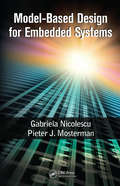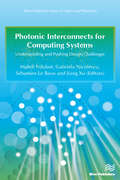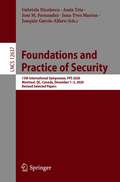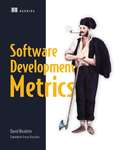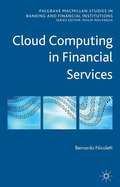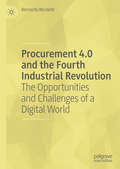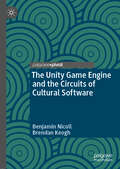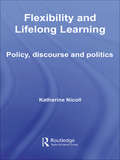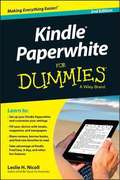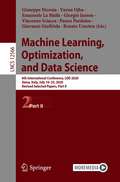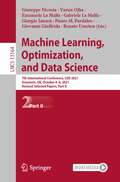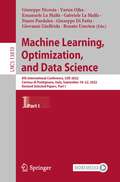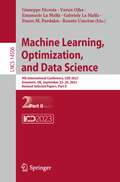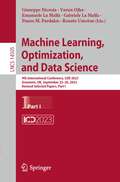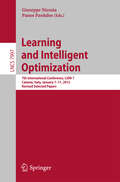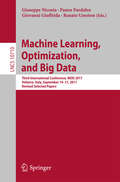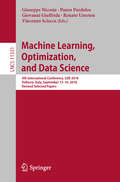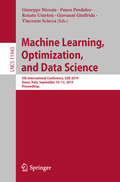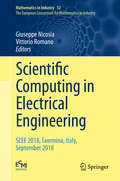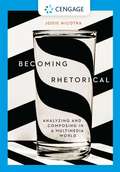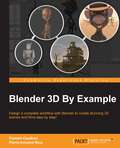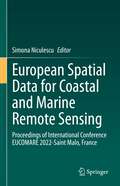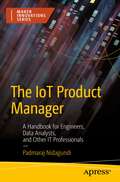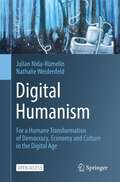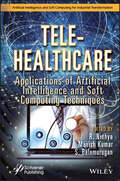- Table View
- List View
Model-Based Design for Embedded Systems (Computational Analysis, Synthesis, and Design of Dynamic Systems)
by Gabriela Nicolescu Pieter J. MostermanThe demands of increasingly complex embedded systems and associated performance computations have resulted in the development of heterogeneous computing architectures that often integrate several types of processors, analog and digital electronic components, and mechanical and optical components—all on a single chip. As a result, now the most prominent challenge for the design automation community is to efficiently plan for such heterogeneity and to fully exploit its capabilities.A compilation of work from internationally renowned authors, Model-Based Design for Embedded Systems elaborates on related practices and addresses the main facets of heterogeneous model-based design for embedded systems, including the current state of the art, important challenges, and the latest trends. Focusing on computational models as the core design artifact, this book presents the cutting-edge results that have helped establish model-based design and continue to expand its parameters.The book is organized into three sections: Real-Time and Performance Analysis in Heterogeneous Embedded Systems, Design Tools and Methodology for Multiprocessor System-on-Chip, and Design Tools and Methodology for Multidomain Embedded Systems. The respective contributors share their considerable expertise on the automation of design refinement and how to relate properties throughout this refinement while enabling analytic and synthetic qualities. They focus on multi-core methodological issues, real-time analysis, and modeling and validation, taking into account how optical, electronic, and mechanical components often interface. Model-based design is emerging as a solution to bridge the gap between the availability of computational capabilities and our inability to make full use of them yet. This approach enables teams to start the design process using a high-level model that is gradually refined through abstraction levels to ultimately yield a prototype. When executed well, model-based design encourages enhanced performance and quicker time to market for a product. Illustrating a broad and diverse spectrum of applications such as in the automotive aerospace, health care, consumer electronics, this volume provides designers with practical, readily adaptable modeling solutions for their own practice.
Photonic Interconnects for Computing Systems: Understanding and Pushing Design Challenges (River Publishers Series In Optics And Photonics Ser.)
by Gabriela Nicolescu Mahdi Nikdast Sébastien Le BeuxIn recent years, there has been a considerable amount of effort, both in industry and academia, focusing on the design, implementation, performance analysis, evaluation and prediction of silicon photonic interconnects for inter- and intra-chip communication, paving the way for the design and dimensioning of the next and future generation of high-performance computing systems. Photonic Interconnects for Computing Systems provides a comprehensive overview of the current state-of-the-art technology and research achievements in employing silicon photonics for interconnection networks and high-performance computing, summarizing main opportunities and some challenges. The majority of the chapters were collected from presentations made at the International Workshop on Optical/Photonic Interconnects for Computing Systems (OPTICS) held over the past two years. The workshop invites internationally recognized speakers on the range of topics relevant to silicon photonics and computing systems. Technical topics discussed in the book include:Design and Implementation of Chip-Scale Photonic Interconnects;Developing Design Automation Solutions for Chip-Scale Photonic Interconnects;Design Space Exploration in Chip-Scale Photonic Interconnects;Thermal Analysis and Modeling in Photonic Interconnects;Design for Reliability;Fabrication Non-Uniformity in Photonic Interconnects;Photonic Interconnects for Computing Systems presents a compilation of outstanding contributions from leading research groups in the field. It presents a comprehensive overview of the design, advantages, challenges, and requirements of photonic interconnects for computing systems. The selected contributions present important discussions and approaches related to the design and development of novel photonic interconnect architectures, as well as various design solutions to improve the performance of such systems while considering different challenges. The book is ideal for personnel in computer/photonic industries as well as academic staff and master/graduate students in computer science and engineering, electronic engineering, electrical engineering and photonics.
Foundations and Practice of Security: 13th International Symposium, FPS 2020, Montreal, QC, Canada, December 1–3, 2020, Revised Selected Papers (Lecture Notes in Computer Science #12637)
by Gabriela Nicolescu Assia Tria José M. Fernandez Jean-Yves Marion Joaquin Garcia-AlfaroThis book constitutes the revised selected papers of the 13th International Symposium on Foundations and Practice of Security, FPS 2020, held in Montréal, QC, Canada, in December 2020. The 11full papers and 1 short paper presented in this book were carefully reviewed and selected from 23 submissions. They cover a range of topics such as Analysis and Detection; Prevention and Efficiency; and Privacy by Design.
Software Development Metrics
by David NicoletteSummarySoftware Development Metrics is a handbook for anyone who needs to track and guide software development and delivery at the team level, such as project managers and team leads. New development practices, including "agile" methodologies like Scrum, have redefined which measurements are most meaningful and under what conditions you can benefit from them. This practical book identifies key characteristics of organizational structure, process models, and development methods so that you can select the appropriate metrics for your team. It describes the uses, mechanics, and common abuses of a number of metrics that are useful for steering and for monitoring process improvement. The insights and techniques in this book are based entirely on field experience.Purchase of the print book includes a free eBook in PDF, Kindle, and ePub formats from Manning Publications.About the BookWhen driving a car, you are less likely to speed, run out of gas, or suffer engine failure because of the measurements the car reports to you about its condition. Development teams, too, are less likely to fail if they are measuring the parameters that matter to the success of their projects. This book shows you how.Software Development Metrics teaches you how to gather, analyze, and effectively use the metrics that define your organizational structure, process models, and development methods. The insights and examples in this book are based entirely on field experience. You'll learn practical techniques like building tools to track key metrics and developing data-based early warning systems. Along the way, you'll learn which metrics align with different development practices, including traditional and adaptive methods.No formal experience with developing or applying metrics is assumed.What's InsideIdentify the most valuable metrics for your team and processDifferentiate "improvement" from "change"Learn to interpret and apply the data you gatherCommon pitfalls and anti-patternsAbout the AuthorDave Nicolette is an organizational transformation consultant, team coach, and trainer. Dave is active in the agile and lean software communities.Table of ContentsMaking metrics usefulMetrics for steeringMetrics for improvementPutting the metrics to workPlanning predictabilityReporting outward and upward
Cloud Computing in Financial Services
by Bernardo NicolettiFinancial institutions must become more innovative in the conduct of their business. Cloud computing helps to achieve several objectives: innovative services, re-engineered processes, business agility and value optimization. Research, consultancy practice and case studies in this book consider the opportunities and risks with vendor relationships.
Procurement 4.0 and the Fourth Industrial Revolution: The Opportunities and Challenges of a Digital World
by Bernardo NicolettiWe are living in the middle of a Fourth Industrial Revolution, with new technology leading to dramatic shifts in everything from manufacturing to supply chain logistics. In a lively, developing field of academic, procurement is often neglected. Despite this, procurement plays a vital role, connecting the organization with its ecosystem. At a time of change and economic crisis, a new business model is called for, which this book aims to define. Based on the applications of Industry 4.0 concepts to procurement, this book describes Procurement 4.0 as a method and a set of tools, helping businesses to improve the value of their products, reduce waste, become more flexible, and address the business needs of the future. It will appeal to academics in the area, as well as practitioners.
The Unity Game Engine and the Circuits of Cultural Software
by Benjamin Nicoll Brendan KeoghVideogames were once made with a vast range of tools and technologies, but in recent years a small number of commercially available 'game engines' have reached an unprecedented level of dominance in the global videogame industry. In particular, the Unity game engine has penetrated all scales of videogame development, from the large studio to the hobbyist bedroom, such that over half of all new videogames are reportedly being made with Unity. This book provides an urgently needed critical analysis of Unity as ‘cultural software’ that facilitates particular production workflows, design methodologies, and software literacies. Building on long-standing methods in media and cultural studies, and drawing on interviews with a range of videogame developers, Benjamin Nicoll and Brendan Keogh argue that Unity deploys a discourse of democratization to draw users into its ‘circuits of cultural software’. For scholars of media production, software culture, and platform studies, this book provides a framework and language to better articulate the increasingly dominant role of software tools in cultural production. For videogame developers, educators, and students, it provides critical and historical grounding for a tool that is widely used yet rarely analysed from a cultural angle.
Flexibility and Lifelong Learning: Policy, Discourse, Politics
by Katherine NicollWhat can the politics of discourse tell us about the discourse of politics? How are flexibility and lifelong learning positioned within policy? Flexibility and lifelong learning have become key aspects of education policy in nation states and bodies such as the European Union and Organisation of Economic Cooperation and Development in recent years. They are positioned as necessary for the knowledge economy and social inclusion. The failure to adapt through becoming more flexible and participating in lifelong learning is held up as a failure at individual, organisational and national levels. But how has that narrative come to be constructed? In what ways is it persuasive? And what forms of political action are possible and necessary? These are the questions addressed in this text. Drawing upon the work of Michel Foucault and on the notion of rhetoric, this book forensically explores examples of the work of policy texts in the discourses of education, lifelong learning and flexibility that they construct. In so doing, it argues for the need to take policy discourse seriously and not simply dismiss it as ‘spin’. Through a detailed examination of policy texts from primarily Australia, the UK and European Union, this text provides insights into the strategies through which flexibility and lifelong learning become realized and realizable as part of the common sense of educational discourse. Rather than simply rejecting these ideas, or suggesting they are merely the window dressing for the more malign interests of the knowledge economy or globalization, it suggests a politics of the wedge and possibilities for the insertion of different meanings. Central to the claims of this text are that we need to engage closely with the discursive and rhetorical strategies of policy, in order that we understand both how it is constructed and thus how it can be deconstructed.
Kindle Paperwhite For Dummies
by Leslie H. NicollGet the inside story on the all-new Kindle Paperwhite with help from For DummiesIt reads like a book, but it's so much more. The Kindle Paperwhite is the ultimate e-reader, and this updated edition of Kindle Paperwhite For Dummies is your ultimate guide to getting more from this one-of-a-kind device. You'll learn to set up your Paperwhite, adjust the font to your liking, find your favorite books, magazines, and newspapers, and sync your Kindle content across devices before moving on to new Paperwhite features like Kindle FreeTime, Goodreads integration, Vocabulary Builder, In-line Footnotes, and Page Flip.Shows you how to navigate the touchscreen, work with the Paperwhite icons, connect via Wi-Fi, customize text size, and get personal recommendationsExplains how to purchase and download books, try out sample chapters before you buy, subscribe to magazines and newspapers, and find free books or books that can be borrowed from the Kindle Lending LibraryTells you how to take advantage of cool Kindle Paperwhite features like encouraging reading with Kindle FreeTime, learning new words with Vocabulary Builder, translating passages into other languages, sharing your recommendations with other readers via Goodreads, and delving deeper into a book's characters and content with X-RayIt's prime time you got to know the powerful, popular Paperwhite with help from Kindle Paperwhite For Dummies, 2nd Edition.
Machine Learning, Optimization, and Data Science: 6th International Conference, LOD 2020, Siena, Italy, July 19–23, 2020, Revised Selected Papers, Part II (Lecture Notes in Computer Science #12566)
by Giuseppe Nicosia Varun Ojha Emanuele La Malfa Giorgio Jansen Vincenzo Sciacca Panos Pardalos Giovanni Giuffrida Renato UmetonThis two-volume set, LNCS 12565 and 12566, constitutes the refereed proceedings of the 6th International Conference on Machine Learning, Optimization, and Data Science, LOD 2020, held in Siena, Italy, in July 2020. The total of 116 full papers presented in this two-volume post-conference proceedings set was carefully reviewed and selected from 209 submissions. These research articles were written by leading scientists in the fields of machine learning, artificial intelligence, reinforcement learning, computational optimization, and data science presenting a substantial array of ideas, technologies, algorithms, methods, and applications.
Machine Learning, Optimization, and Data Science: 7th International Conference, LOD 2021, Grasmere, UK, October 4–8, 2021, Revised Selected Papers, Part II (Lecture Notes in Computer Science #13164)
by Giuseppe Nicosia Varun Ojha Emanuele La Malfa Gabriele La Malfa Giorgio Jansen Panos M. Pardalos Giovanni Giuffrida Renato UmetonThis two-volume set, LNCS 13163-13164, constitutes the refereed proceedings of the 7th International Conference on Machine Learning, Optimization, and Data Science, LOD 2021, together with the first edition of the Symposium on Artificial Intelligence and Neuroscience, ACAIN 2021. The total of 86 full papers presented in this two-volume post-conference proceedings set was carefully reviewed and selected from 215 submissions. These research articles were written by leading scientists in the fields of machine learning, artificial intelligence, reinforcement learning, computational optimization, neuroscience, and data science presenting a substantial array of ideas, technologies, algorithms, methods, and applications.
Machine Learning, Optimization, and Data Science: 8th International Workshop, LOD 2022, Certosa di Pontignano, Italy, September 19–22, 2022, Revised Selected Papers, Part I (Lecture Notes in Computer Science #13810)
by Giuseppe Nicosia Varun Ojha Emanuele La Malfa Gabriele La Malfa Panos Pardalos Giuseppe Di Fatta Giovanni Giuffrida Renato UmetonThis two-volume set, LNCS 13810 and 13811, constitutes the refereed proceedings of the 8th International Conference on Machine Learning, Optimization, and Data Science, LOD 2022, together with the papers of the Second Symposium on Artificial Intelligence and Neuroscience, ACAIN 2022. The total of 84 full papers presented in this two-volume post-conference proceedings set was carefully reviewed and selected from 226 submissions. These research articles were written by leading scientists in the fields of machine learning, artificial intelligence, reinforcement learning, computational optimization, neuroscience, and data science presenting a substantial array of ideas, technologies, algorithms, methods, and applications.
Machine Learning, Optimization, and Data Science: 9th International Conference, LOD 2023, Grasmere, UK, September 22–26, 2023, Revised Selected Papers, Part II (Lecture Notes in Computer Science #14506)
by Giuseppe Nicosia Varun Ojha Emanuele La Malfa Gabriele La Malfa Panos M. Pardalos Renato UmetonThis book constitutes the refereed proceedings of the 9th International Conference on Machine Learning, Optimization, and Data Science, LOD 2023, which took place in Grasmere, UK, in September 2023. The 72 full papers included in this book were carefully reviewed and selected from 119 submissions. The proceedings also contain 9 papers from and the Third Symposium on Artificial Intelligence and Neuroscience, ACAIN 2023. The contributions focus on the state of the art and the latest advances in the integration of machine learning, deep learning, nonlinear optimization and data science to provide and support the scientific and technological foundations for interpretable, explainable and trustworthy AI.
Machine Learning, Optimization, and Data Science: 9th International Conference, LOD 2023, Grasmere, UK, September 22–26, 2023, Revised Selected Papers, Part I (Lecture Notes in Computer Science #14505)
by Giuseppe Nicosia Varun Ojha Emanuele La Malfa Gabriele La Malfa Panos M. Pardalos Renato UmetonThis book constitutes the refereed proceedings of the 9th International Conference on Machine Learning, Optimization, and Data Science, LOD 2023, which took place in Grasmere, UK, in September 2023. The 72 full papers included in this book were carefully reviewed and selected from 119 submissions. The proceedings also contain 9 papers from and the Third Symposium on Artificial Intelligence and Neuroscience, ACAIN 2023. The contributions focus on the state of the art and the latest advances in the integration of machine learning, deep learning, nonlinear optimization and data science to provide and support the scientific and technological foundations for interpretable, explainable and trustworthy AI.
Learning and Intelligent Optimization
by Giuseppe Nicosia Panos PardalosThis book constitutes the proceedings of the 7th International Conference on Learning and Optimization, LION 7, which was held in Catania, Italy, in January 2013. The 49 contributions presented in this volume were carefully reviewed and selected from 101 submissions. They explore the intersections and uncharted territories between machine learning, artificial intelligence, mathematical programming and algorithms for hard optimization problems.
Machine Learning, Optimization, and Big Data: Third International Conference, MOD 2017, Volterra, Italy, September 14–17, 2017, Revised Selected Papers (Lecture Notes in Computer Science #10710)
by Giuseppe Nicosia Panos Pardalos Giovanni Giuffrida Renato UmetonThis book constitutes the post-conference proceedings of the Third International Workshop on Machine Learning, Optimization, and Big Data, MOD 2017, held in Volterra, Italy, in September 2017.The 50 full papers presented were carefully reviewed and selected from 126 submissions. The papers cover topics in the field of machine learning, artificial intelligence, computational optimization and data science presenting a substantial array of ideas, technologies, algorithms, methods and applications.
Machine Learning, Optimization, and Data Science: 4th International Conference, LOD 2018, Volterra, Italy, September 13-16, 2018, Revised Selected Papers (Lecture Notes in Computer Science #11331)
by Giuseppe Nicosia Panos Pardalos Giovanni Giuffrida Renato Umeton Vincenzo SciaccaThis book constitutes the post-conference proceedings of the 4th International Conference on Machine Learning, Optimization, and Data Science, LOD 2018, held in Volterra, Italy, in September 2018.The 46 full papers presented were carefully reviewed and selected from 126 submissions. The papers cover topics in the field of machine learning, artificial intelligence, reinforcement learning, computational optimization and data science presenting a substantial array of ideas, technologies, algorithms, methods and applications.
Machine Learning, Optimization, and Data Science: 5th International Conference, LOD 2019, Siena, Italy, September 10–13, 2019, Proceedings (Lecture Notes in Computer Science #11943)
by Giuseppe Nicosia Panos Pardalos Renato Umeton Giovanni Giuffrida Vincenzo SciaccaThis book constitutes the post-conference proceedings of the 5th International Conference on Machine Learning, Optimization, and Data Science, LOD 2019, held in Siena, Italy, in September 2019. The 54 full papers presented were carefully reviewed and selected from 158 submissions. The papers cover topics in the field of machine learning, artificial intelligence, reinforcement learning, computational optimization and data science presenting a substantial array of ideas, technologies, algorithms, methods and applications.
Scientific Computing in Electrical Engineering: SCEE 2018, Taormina, Italy, September 2018 (Mathematics in Industry #32)
by Giuseppe Nicosia Vittorio RomanoThis collection of selected papers presented at the 12th International Conference on Scientific Computing in Electrical Engineering, SCEE 2018, held in Taormina, Sicily, Italy, in September 2018, showcases the state of the art in SCEE.The aim of the SCEE 2018 conference was to bring together scientists from academia and industry, mathematicians, electrical engineers, computer scientists, and physicists, and to promote intensive discussions on industrially relevant mathematical problems, with an emphasis on the modeling and numerical simulation of electronic circuits and of electromagnetic fields. This extensive reference work is divided into five parts: Computational Electromagnetics, Device Modeling and Simulation, Circuit Simulation, Mathematical and Computational Methods, Model Order Reduction. Each part starts with a general introduction, followed by the respective contributions. The book will appeal to mathematicians and electrical engineers. Further, it introduces algorithm and program developers to recent advances in the other fields, while industry experts will be introduced to new programming tools and mathematical methods.
Becoming Rhetorical: Analyzing And Composing In A Multimedia World
by Jodie NicotraBecoming rhetorical is a transformation that allows students to identify rhetorical problems and respond to them with arguments, no matter the course or context from which the problems emerge. In BECOMING RHETORICAL, author Jodie Nicotra takes students beyond the view of the rhetorical situation as being composed of communicator, audience, and message, encouraging them also to consider important aspects such as exigence, purpose, and the means of communication. Students learn to analyze and compose in textual, visual, and multimodalities -- from evaluating an op-ed piece, to making a video of a consumer product, to creating an entire public awareness campaign -- thereby becoming confident critical thinkers in a 21st century multimedia world.
Blender 3D By Example
by Pierre-Armand Nicq Romain CaudronDesign a complete workflow with Blender to create stunning 3D scenes and films step-by-step! About This Book * Give life to a character within a full animated short film by learning the rigging and animation process * Make use of the powerful tools available in Blender to produce professional-quality 3D characters and environments * Discover advanced techniques by adding fur to a character, creating a grass field, and fine-tuning a shot with post-processing effects to enhance your creations Who This Book Is For This book will give any beginner the necessary skills and knowledge to create own 3D projects with Blender. You don't need to have any previous experience in 3D modeling, but if you do, then this book is a great way get you started with Blender. This book is for anyone who wants to learn Blender by creating concrete projects. What You Will Learn * Understand the basics of 3D and how to navigate your way around the Blender interface * Create a 3D robot toy model from start to finish using the basic modeling tools of Blender * Make a full alien character using the skin mesh modifier and the sculpting tools with an artistic approach * Use re-topology techniques to create a clean 3D version of the previously sculpted alien * Model a full haunted house and its environment using more advanced modeling tools and techniques such as the Array Modifier, Instance duplication, or Curves * Discover the power of the texture paint tool in order to add color to the haunted house * Get to know the Cycles render engine by creating different materials for the house and the environment In Detail Blender is a powerful tool, stable, with an integral workflow that will allow you to understand your learning of 3D creation with serenity. Today, it is considered to be one of the most complete 3D packages on the market and it is free and open source! It is very efficient for many types of productions, such as 3D animated or live action films, architecture, research, or even game creation with its integrated game engine and its use of the Python language. Moreover, Blender has an active community that contributes to expanding its functionalities. Today, it is used in many professional products and by many companies. Through this book, you will create many types of concert projects using a step-by-step approach. You will start by getting to know the modeling tools available in Blender as you create a 3D robot toy. Then, you will discover more advanced techniques such as sculpting and re-topology by creating a funny alien character. After that, you will create a full haunted house scene. For the last project, you will create a short film featuring a rat cowboy shooting cheese in a rat trap! This will be a more complex project in which you learn how to rig, animate, compose advanced material, composite, and edit a full sequence. Each project in this book will give you more practice and increase your knowledge of the Blender tools. By the end of this book, you will master a workflow that you will be able to apply to your own creations. Style and approach This is an easy-to-follow book that is based on four concrete projects, with increasing levels of difficulty. Each chapter will teach you how to create these projects step-by-step. New tools and techniques are introduced in a theoretical and practical way, so you can apply them in your own projects later.
European Spatial Data for Coastal and Marine Remote Sensing: Proceedings of International Conference EUCOMARE 2022-Saint Malo, France
by Simona NiculescuThis volume presents full paper contributions from the International Conference of European Spatial Data for Coastal and Marine Remote Sensing (EUCOMARE) 2022, with the support of the ERASMUS+ Programme of the European Union, held in Saint Malo, France. EUCOMARE aims to promote academic and technical exchange on coastal related studies including coastal environmental and socio-economic issues, with the use of European remotely sensed data. The book is an excellent resource for scientists, engineers, and programme managers eager to learn about the recent developments and achievements in the field of remote sensing applications on marine and coastal areas. Readers will learn about recent advances in sensors' radiometric, spatial, temporal and spectral resolution, as well as new data processing approaches in remote sensing for monitoring and mapping the various characteristics of marine, coastal and aquatic systems.
The IoT Product Manager: A Handbook for Engineers, Data Analysts, and Other IT Professionals
by Padmaraj NidagundiEnhance your product management skills and set yourself apart from other product managers working in the IoT industry. This book shows you how to navigate through the world of small and Edge devices to successfully launch and monitor products connected together to make smart environments.Working in Agile environments, you'll learn to guide UI builds that serve customer needs and function the way top tech companies expect. Then measure the right product metrics and create reporting dashboards for your IoT products. That way you can effectively engage partners, engineers, and stakeholders. And you’ll learn the entire end-to-end development process of IoT products so that you can make sure you make the right moves at the right stages. After mastering the IoT product lifecycle and measuring your success against KPIs, you’ll see how to work with marketing to effectively launch your product in the marketplace. Finally, a self-interview section has been provided so that you can evaluate your skills and responses to common IoT Product Manager questions. Then take what you've learned and go out into the world to develop integrated IoT products that your customers love!What You'll LearnCreate UI/UX experiences that engage and wow your customersWork in Agile environments with best business practicesNegotiate effectively at each step of the product lifecycleWho This Book Is ForAny wanting to build a IoT products. Aspiring Internet of Things product managers, product owners, analysts, business consultants, engineers, and business owners.
Digital Humanism: For a Humane Transformation of Democracy, Economy and Culture in the Digital Age
by Julian Nida-Rümelin Nathalie WeidenfeldThis open access book deals with cultural and philosophical aspects of artificial intelligence (AI) and pleads for a “digital humanism”. This term is beginning to be en vogue everywhere. Due to a growing discontentment with the way digitalization is being used in the world, particularly formulated by former heroes of Internet, social media and search engine companies, philosophical as well as industrial thought leaders begin to plead for a humane use of digital tools. Yet the term “digital humanism” is a particular terminology that lacks a sound conceptual and philosophical basis and needs clarification still – and this gap is exactly filled by this book. It propagates a vision of society in which digitization is used to strengthen human self-determination, autonomy and dignity and whose time has come to be propagated throughout the world. The advantage of this book is that it is philosophically sound and yet written in a way that will make it accessible for everybody interested in the subject. Every chapters begins with a film scene illustrating a precise philosophical problem with AI and how we look at it – making the book not only readable, but even entertaining. And after having read the book the reader will have a clear vision of what it means to live in a world where digitization and AI are central technologies for a better and more humane civilization.
Tele-Healthcare: Applications of Artificial Intelligence and Soft Computing Techniques
by R. Nidhya Manish Kumar S. BalamuruganTELE-HEALTHCARE This book elucidates all aspects of tele-healthcare which is the application of AI, soft computing, digital information, and communication technologies, to provide services remotely and manage one’s healthcare. Throughout the world, there are huge developing crises with respect to healthcare workforce shortages, as well as a growing burden of chronic diseases. As a result, e-health has become one of the fastest-growing service areas in the medical sector. E-health supports and ensures the availability of proper healthcare, public health, and health education services at a distance and in remote places. For the sector to grow and meet the need of the marketplace, e-health applications have become one of the fastest growing areas of research. However, to grow at a larger scale requires the following: The availability of user cases for the exact identification of problems that need to be visualized. A well-supported market that can promote and adopt the e-health care concept. Development of cost-effectiveness applications and technologies for successful implementation of e-health at a larger scale. This book mainly focuses on these three points for the development and implementation of e-health services globally. In this book the reader will find: Details of the challenges in promoting and implementing the telehealth industry. How to expand a globalized agenda of personalized telehealth in integrative medical treatment for disease diagnosis and its industrial transformation. How to design machine learning techniques for improving the tele-healthcare system. Audience Researchers and post-graduate students in biomedical engineering, artificial intelligence, and information technology; medical doctors and practitioners and industry experts in the healthcare sector; healthcare sector network administrators.
